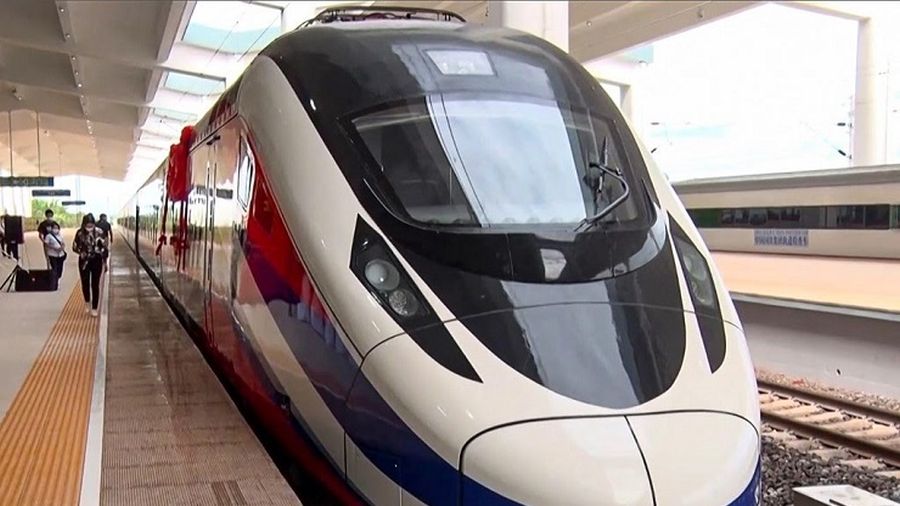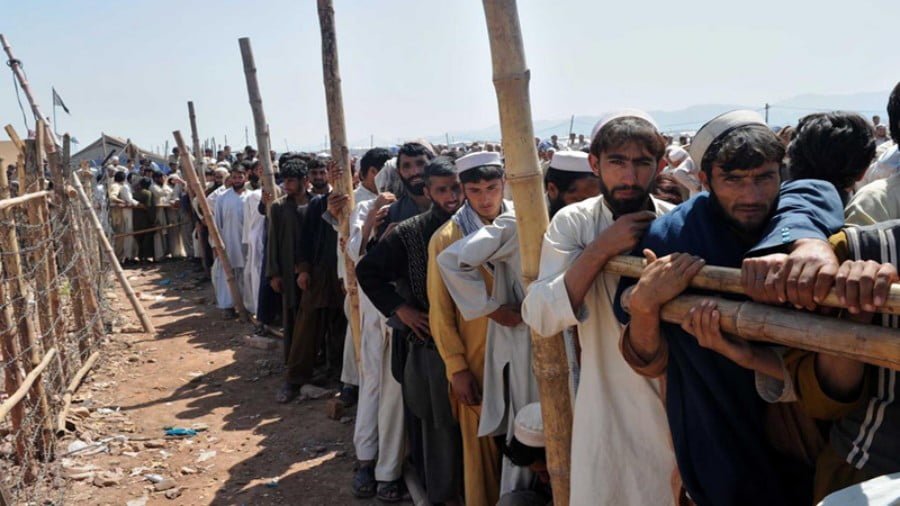Laos’ Railway Opens: The West Kicks and Screams as China and Laos Move Forward Together
The China-Laos railway, connecting the landlocked Southeast Asian nation of Laos with China, has finally begun operations. This historic moment marked a new chapter for Laos which remains one of the poorest nations in the region.
Besides the devastation wrought by US war with neighboring Vietnam last century which saw the US drop more bombs on Laos than any other nation on Earth in human history – the Laotian economy has also long suffered from isolation owed to its difficult geography. Not only is Laos landlocked, it features terrain marked with mountains, valleys, and rivers that have hampered even the most basic movement of people and goods within the country’s borders and beyond them.
This has recently changed through a series of modern highways also built by China bringing the 3 day trip from Kunming, China to Laos’ capital Vientiane down to under a day. With the high speed railway now in operation, goods and people will move even faster with the trip from Vientiane near the Thai-Laos border to Laos’ border with China taking only 3 hours.
In order to build the 422 kilometer China-Laos railway 75 tunnels and over 60 km of bridges were built, just to gain an idea of how daunting Laos’ geography is and what Chinese engineers accomplished in building the new railway.
The railway is part of a much larger regional project which will eventually connect China and Laos to Thailand and perhaps even Malaysia and Singapore. The Thai leg of the network – featuring high-speed rail – is already under construction and regular rail already exists connecting Thailand’s cities and ports to the Thai-Laos border via the Thai city of Nong Khai.
With very little effort Laos’ new railway can be connected with existing Thai rail networks before the China-Thailand high-speed railway is even completed.
Ending Laos’ Chronic Poverty
Chinese-built infrastructure has enabled Laos’ economy to rapidly grow annually. Chinese-built highways coupled with the new railway, and future projects both along the China-Laos railway and connecting to Thailand will continue expanding Laos’ economy in ways it otherwise could not.
A Bangkok Post article titled, “Calls to speed up link to Laos-China line,” would note:
The cost of shipments from Vientiane to Kunming in the southern Chinese province of Yunnan will be cut by 40-50% or US$30 per tonne, along with a 20-40% cost reduction on domestic routes, according to a World Bank report “From landlocked to land-linked: unlocking the potential of Lao-China rail connectivity”.
Exports from Laos to China were worth $1.7 billion in 2019 and could expand by about 20% per year, a report by UN Comtrade has said.
China is also Laos’ largest source of tourism with a direct link between China’s high-speed railway and the new China-Laos railway making it even easier for larger numbers of tourists to visit Laos, further enhancing Laos’ economic prospects.
Laos is being transformed from an isolated and impoverished state to an integral hub connecting East Asia to Southeast Asia. In the process, Laos itself will leave behind decades of chronic poverty and begin enjoying the prosperity of its ASEAN neighbors.
The West Mourns China and Laos’ Success
The China-Laos railway stands to move Laos from chronic poverty to potential prosperity, thanks to an infrastructure drive that is itself a marvel of modern engineering. One would think that alone should attract praise from around the globe and from the West first and foremost, a region and political bloc that poses as the globe’s patron of development and progress.
Yet in reality the West has enjoyed primacy worldwide precisely because its rhetoric regarding development and progress is deliberately empty with all efforts made to in fact delay, arrest, or even reverse progress made beyond Western borders. The West represents a fraction of the global population and in order to maintain primacy over the rest of the globe, arresting or reversing development is an absolute necessity.
China through its Belt and Road Initiative (BRI) has disrupted Western primacy by creating the infrastructure nations need to be prosperous individually and regions of the planet to be prosperous collectively.
While for most people Laos’ new railway is an exciting achievement and a sign of promise, for the West it is yet another sign of its waning power over the world and the shifting of its once uncontested power eastward.
Articles like The Diplomat’s “Laos-China Railway Inaugurated Amid Mounting Debt Concerns,” penned by Sebastian Strangio illustrate the West’s frustration and dismay as once “third world” nations obtain first world infrastructure.
Strangio’s article collects a variety of vague and unconvincing concerns expressed by Western pundits over Laos’ debt to China – as if they’ve “discovered” that building the new railway costs money and created debt. A cart before the horse argument is formulated claiming that because Laos is impoverished it will be unable to pay off the railway – failing to note that Laos is poor in the first place because it lacks basic infrastructure.
Strangio’s argument is not unique. Western headlines were full of similar narratives – apparently confident that Western audiences do not understand the long-term and indirect benefits massive infrastructure investment represents.
Sidestepping these otherwise irrelevant arguments is the heart of the West’s real issue with Laos’ new railway, that Laos is moving out from under the shadow of the West’s imperial legacy in the region and away from its various manifestations today.
Laos’ growing relationship with China also drives Western hand-wringing over the new railway, with claims suggesting China is all but taking over its small neighbor to the south. At one point an Associated Press article would quote Scott Morris of the Center for Global Development in Washington who claimed, “this is essentially a Chinese public infrastructure project that happens to exist in another country,” suggesting the project provides little if any benefit beyond China itself.
For ASEAN as a whole, the tangible benefits of doing business with China are obvious. Connectivity increases these benefits and as China rises the region rises with it. Together Asia is surpassing not only the United States but the West in general.
The railways China is building across the region travel both ways. They move Chinese-made goods into the region, but also Chinese tourists who spend money in Southeast Asia. When the trains return to China they will be taking with them exports from Southeast Asia. In regards to Laos, its economy is only achieving growth specifically because of Chinese-built infrastructure. There is no reason to believe, and the West has made no convincing argument to suggest otherwise – that the new railway wouldn’t simply enhance this trend further.
The West Has Only Itself to Blame
Strangio laments in his article that most of Laos’ debt is owed to China. But that isn’t because China is somehow preying on Laos. It’s because China is the only large global power that is able and willing to build the infrastructure Laos requires – be it rail or road.
The West had a multi-decade headstart over China but instead of building infrastructure across Southeast Asia during the “American century,” it bombed the region instead.
There are still an estimated 80 million submunitions scattered across Laos after America’s destructive war on Vietnam and its neighbors. That works out to about 11 for each man, woman, and child who lives in Laos. 20,000 people have been killed by unexploded US munitions and many more maimed which includes losing limbs.
According to the Lao National Unexploded Ordnance Programme (UXO LAO), 444,711 submunitions (about 0.55%) have been destroyed between 1996 and 2010. Despite the dangerous and exhausting work, eliminating 0.55% of the 80 million submunitions still littering the country amounts to virtually nothing.
The Diplomat, in a 2016 article titled, “Obama in Laos: Cleaning up After the Secret War,” would claim:
In recent years, US support for UXO clearance and victim assistance in Laos has dramatically increased. In response to steady pressure from NGOs like Legacies of War and their allies in Congress, US funding for this work increased from $5 million in 2010 to a record $19.5 million this year. These resources, disbursed by the State Department’s Office of Weapons Removal and Abatement, are used to support clearance efforts that destroy up to 100,000 pieces of lethal ordnance in Laos annually, employing 3,000 workers in the commercial and humanitarian sectors.
At 100,000 submunitions per year, Laos should be safe from unexploded munitions in just under 1,000 years which for all intents and purposes means “never.”
In other words, the US and its allies have an insurmountable task ahead of them just to clean up the mess they’ve made in Laos nearly half a century ago. They also lack the ability or even the will to assist Laos in meaningful development including the building of essential infrastructure like roads and railways.
The West – as it stands currently – is organized solely around the pursuit of global hegemony in a world that has begun moving beyond the sort of socioeconomic and technological disparity that made the pursuit of hegemony viable in the first place. As the window continues to close on the effectiveness of the tools the West uses to pursue its brand of foreign policy, the resentment and resistance in the West to China’s rise and the rise of nations partnered with it will grow.
The Western media suggests Laos would be better off without China’s “influence,” but imagine where Laos would be without China. A trip from its capital Vientiane to the Laotian border with China would take 3 days over dusty, narrow, winding mountainous roads barely accommodating 2-way traffic in a nation that’s been mired in poverty for decades, and a nation that would otherwise be facing a bleak future with decades more of poverty awaiting.
Laos as a prosperous crossroads between East Asia and Southeast Asia is not something you need to imagine. It is a reality – thanks to China. It is a reality that you can experience today, by buying a ticket on Laos’ new railway.







